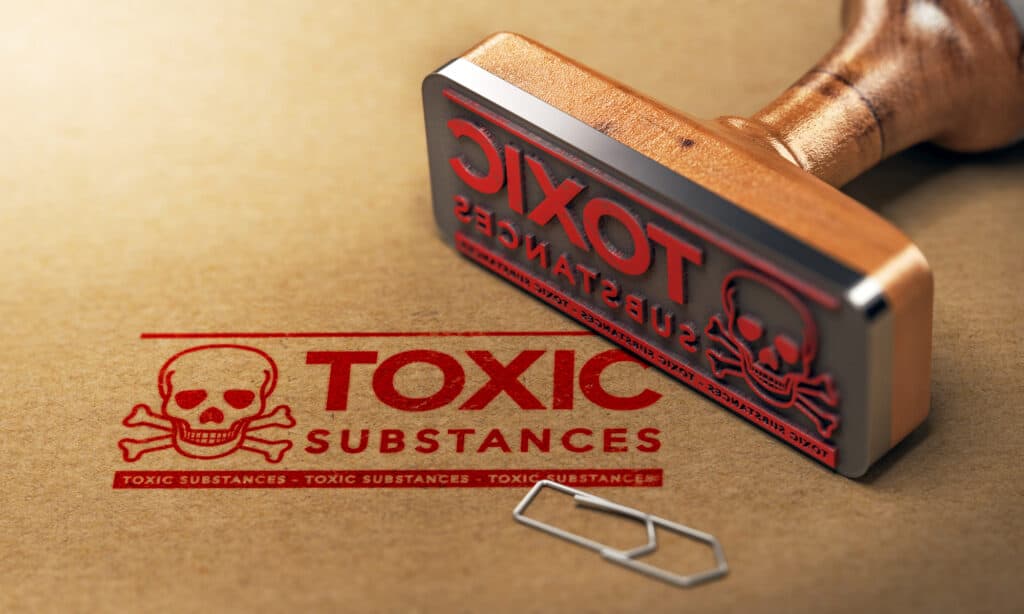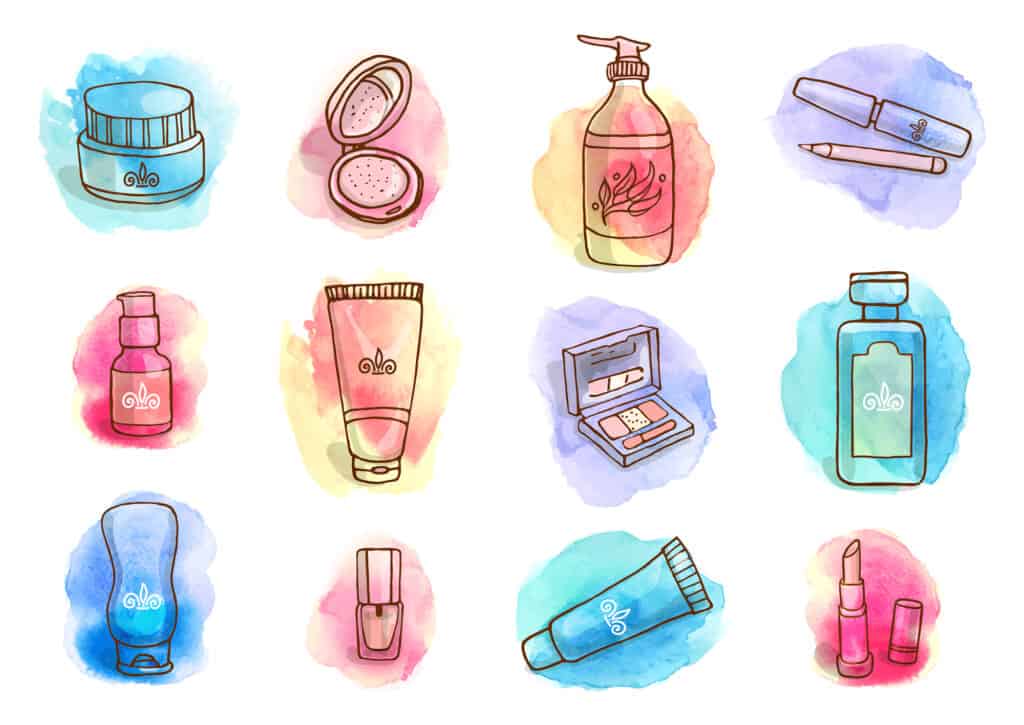SUMMARY: When we make decisions about what to put in, on, or around our bodies, it’s a smart idea to consider the risk to benefit ratio. “Is this worth it?” is a fine question to ponder. In the case of conventional cosmetics or personal care products, chock-full of toxic chemicals, you might ask, “Is X benefit to my outer appearance worth X risk to my physical and mental health?” Exploring natural alternatives with nutrient-rich, food grade ingredients is a worthy option to take into account. As long as you’re informed from trusted sources, you have the opportunity to choose what’s right for you.
Written by Lori Thayer, Ph.D.
Edited by Nicki Steinberger, Ph.D.
The extent of exposure to environmental contaminants in the air, water, soil, food, and consumer goods is unprecedented, and in many cases unavoidable. When considering cosmetic and personal care products, it’s important to know you have a choice.
While present estimates vary, the EPA’s February 2022 Toxic Substances Control Act Chemical Substance Inventory (TSCA Inventory), which is updated approximately every six months, contains 86,631 chemicals.
Most cosmetics and household items displayed in the aisles of local grocery, drug, and department stores contain numerous known toxic chemicals. However, there are natural alternatives available.
What you choose to put on your body goes beyond its superficial effects. It impacts your internal “make-up,” and leaves a trail of potential contamination in its wake. In an effort to beautify, consider applying healthy products on your skin that will enhance your body within and beyond.
A new HBO Max documentary, “NOT SO PRETTY,” aired its first episode in April 2022 with the goal of providing a comprehensive exposé on the unregulated beauty industry in the United States.
While you may be surprised to learn that this industry is essentially unregulated, the issue extends beyond regulation. Regulation requires integrity at many levels of government, and only partially addresses the concerns for safety.
Three Areas of Significant Impact From Cosmetic and Personal Care Products
- Human Impact: Namely on the consumer (as well as any other person who comes in contact with the substances during production or disposal)
- Environmental Impact: May occur in the manufacturing process, as well as intentional or inadvertent disposal of ingredients
- Animal Impact: The result of animal testing of products in laboratories, and waste in oceans or on land where animals roam
A breakdown of these three areas of concern:
One – Human Impact: The trillion dollar cosmetic industry is governed differently from country to country. While the European Union conducts pre-market safety assessments of cosmetic ingredients and the European Commission actively regulates individual ingredients, the correlating U.S. Food and Drug Administration (FDA) minimally regulates cosmetic ingredients, and does not regulate the production nor disclosure of chemicals included in fragrance additives.
A perfume may simply list the word “fragrance” on its label that may include several highly-toxic chemicals. Whereas drugs must meet FDA regulations with respect to safety and effectiveness, the cosmetic industry holds the responsibility of substantiating the safety of its own products and ingredients before marketing. It goes without saying, self-monitoring tends to have limits when profits are involved.
Two – Environmental Impact: Throughout the manufacturing, distribution, and disposal process, toxic chemicals end up in the environment. Discharges may occur in the ground, air, or water. Although this issue is rarely included in discussions of toxic chemicals found in beauty products, one study conducted in the San Francisco Bay area in 2007 measured high levels of triclosan found in more than 40 percent of wastewater samples.
Triclosan persists in the environment, is toxic to aquatic organisms, and can transform into cancer-causing chemicals such as dioxins, chloroform and 4-chloroaniline. Although the FDA banned the use of triclosan in 2017 in regulated products, it’s still used in many cosmetics and personal care products as a preservative and antibacterial agent. It should be noted: If one persistent chemical can make its way into the environment, it’s likely others do too.
Three – Animal Impact: An issue that’s generally addressed separately from the discussion of human impacts, is the practice of animal laboratory safety tests. Granted, there is tension here in terms of conflicting agendas. For some, more animal studies means more information on “safe” usage of potentially toxic ingredients. For others, the use of animals in laboratory testing is abhorrent.
The European Union banned animal testing on finished cosmetic products in 2004, and banned animal testing on cosmetic ingredients in 2009. The U.S. doesn’t mandate testing of cosmetics on animals, and the cosmetic industry uses this practice as a way to support marketing claims of safety.
To date, nine states have banned the sale of animal-tested beauty products: California, Nevada, Illinois, Louisiana, Hawaii, Virginia, Maryland, New Jersey, and Maine. New York may be next according to the current status on Senate Bill S4839B. PETA (People for Ethical Treatment of Animals) has been a strong voice for change and the dissolution of all practices of vivisection.
The multi-million dollar industry within the scientific community has strong resistance against the movement of ending animal cruelty. In addition, many people believe testing on animals is a necessary evil to protect human health.
However, with respect to cosmetics (and various other consumer products), there are compassionate alternatives such as human cell-based tests and computer modeling. Therefore, the trade-off between human safety and animal cruelty need not exist.

Hormone Disruptors, Carcinogens, and Forever Chemicals
While over 1000 ingredients are banned for use in personal care products in Europe, the U.S. has a list of only 11 banned ingredients:
- Bithionol
- Chlorofluorocarbon propellants
- Chloroform
- Halogenated salicylanilides (di-, tri-, metabromsalan and tetrachlorosalicylanilide)
- Hexachlorophene
- Mercury compounds
- Methylene chloride
- Prohibited cattle materials
- Sunscreens in cosmetics
- Vinyl chloride
- Zirconium-containing complexes
The FDA, however, does say that “safe” cosmetics may be “unsafe” if used the wrong way. That’s interesting; do you know anyone that eats skin care lotion or applies eye shadow where “the sun don’t shine?” Make sure you follow those instructions!
In addition, if you think your lip liners, hair creams, or tanning products have been approved by the FDA, it’s important you know this:
“Under U.S. law, cosmetic products and ingredients, other than color additives, do not need FDA approval before they go on the market. Cosmetic manufacturers have a legal responsibility for the safety and labeling of their products. FDA can and does take action against cosmetics on the market that do not comply with the law.”
Studies have shown that over half of the beauty products marketed in the U.S. contain one or more harmful ingredients, some of which are identified as hormone disruptors (such as triclosan and phthalates), human carcinogens (formaldehyde, parabens, and triclosan), and PFAS known as “forever chemicals” because they do not break down in the environment or human tissue. At least 11 chemicals and chemical families of concern have been uncovered that are commonly used in cosmetics.
The Terrible Twelve: On BrainMD, Dr. Daniel Amen, renowned psychiatrist and brain disorder specialist, shared the “dirty dozen” list of the most harmful toxic ingredients in cosmetics, to help you avoid purchasing products containing these substances.
- BHA and BHT
- Formaldehyde
- Sodium Laureth Sulfate
- Parabens
- Siloxanes
- Triclosan
- Coal Tar Dyes
- Parfum (aka Fragrance)
- Petrolatum
- DEA Compounds
- Phthalates
- Polyethylene Glycols
Advocates of the cosmetic industry have argued that the amount of so-called toxic ingredients in beauty products is minimal and studies have not clearly proven their adverse effects. Yet even without detailed research, serious questions have been raised with respect to the synergistic effects of multiple toxins bioaccumulating in the body.
Present-day research is attempting to study the effects of combinations of contaminants, but it’s impossible to even begin to measure all the possible mixtures that are carried in our bodies.
Given there are companies who manufacture healthy, non-toxic beauty and personal care products, perhaps it’s time to consider switching, or making your own products at home with simple, safe ingredients.
Research, Recipes, and DIY
Applying cosmetics and using beauty products that enhance your body outside and in, along with protecting the environment and the lives of animals, can be a beautiful act of choice.
The Environmental Working Group (EWG) is an environmental health advocacy organization based in the United States that provides a website in which cosmetic products are given a hazard score based on the ingredients’ links to cancer, allergies, and other issues.
Presently EWG lists 89,551 products, 2,992 brands, and 2,140 EWG VERIFIED™ products based on EWG’s strict scientific standards for transparency and health.
MadeSafe uses a unique “Ecosystem Approach,”—science-based, independent, and third party review—in their sourcing and certification of clean, eco-friendly products.
Should you be ready to stir up your own batch of goodies to ensure the safest possible ingredients, check out SavvyChaser’s list of handmade recipes for 45 personal care products from A to Z: Antiseptic Ointment to Zit Zapper!
Popular ingredients include essential oils, coconut oil, aloe vera, and herbs; always choose organic if you can.
The Power of Belief From Young to Old
With cosmetic surgery on the rise, and young girls reaching for make-up at such young ages, is it a stretch to believe your beauty stands on its own without enhancements? For many, the answer is yes.
Where does education begin for girls at an early age who associate how they look with their sense of self and overall worth? Though it’s beyond the scope of this article to dig in further and do this topic justice, it’s apparent the lack of self-worth from over-focus on image, aggressive advertising, and peer pressure can lead to eating disorders and other mental health issues. The Renfrew Center Foundation states:
“The Renfrew Center Foundation, a non-profit charitable organization dedicated to advancing the education, prevention, research, advocacy and treatment of eating disorders, today announced survey results, which revealed at least one in five young girls between the ages of 8 and 18 who have ever worn makeup have negative feelings about their image when not wearing makeup, associating a “bare face” with feeling insecure and unattractive. Additionally, two-thirds of the girls surveyed who wore makeup began doing so between the ages of 8 and 13.”
Then Again… How About No Make-Up?
It’s just a thought; perhaps a possibility—barefaced and beautiful.
For some women and girls it’s the desire to enhance; for others the need to “cover-up” their faces, recreate themselves into what they’ve been made to believe “real women” look like, and be “better,” a.k.a. more acceptable—to society and themselves. Author, Lux Alptraum concludes:
“We’ve bought into the notion that it’s not merely desirable but downright mandatory to invest time and money and effort into maintaining this charade of what “real women” look like — even as that charade reinforces some of the most noxious aspects of American society.”
Women in the spotlight have spoken up:
Singer, songwriter, activist, Alicia Keys became addicted to wearing make-up, and felt uncomfortable within herself when she wasn’t wearing any. The pressure was so great to be “fabulous,” it came with a bundle of stress.
In 2016, she declared enough was enough, and decided it was “Time to Uncover.” This was when she publicly shared her decision to embrace natural beauty. Alicia wrote:
“I don’t want to cover up anymore. Not my face, not my mind, not my soul, not my thoughts, not my dreams, not my struggles, not my emotional growth. Nothing.”
The choice to wear make-up or not is yours, and if it doesn’t feel like you have a choice, slow down, pause, and connect with who you truly are.
20-year-old, Melisa Raouf, was the first woman in the Miss England Pageant’s 94-year history to compete without make-up.
In 2022, with a desire to defy beauty standard norms, challenge the social media fallacy of how women are supposed to look, and emphasize the importance of allowing inner beauty to shine, Melisa took to the stage without concealment or disguise—barefaced and proud.
Raouf, who’s an advocate for youth mental health, said:
“With mental health being such a big topic, I want to make all girls feel good. I just want to remove all the beauty standards. I feel like all girls are beautiful in their own way, I feel like I’ve done it for all girls.”

Believe in Your Ability to Make Things Better
Do you feel inspired to be part of the solution to decrease the impact of toxicity on humans, the environment, and animals, while increasing good health, vibrancy, and self-love?
If you feel moved to support the natural cosmetics and home products movements, be willing to do a detailed inspection of what you put on and around your body, and what you give others, including friends and family. EWG’s consumer guides can help lead you in the right direction.
Purchase organic goods with a minimal number of ingredients—food grade (not cosmetic grade) and recognizable. If you don’t understand what a particular item is, research it yourself, or ask someone who’s been accustomed to living a natural lifestyle.
There’s a high likelihood you’ll feel exceptionally relieved using pure ingredients on your skin and in your home. Using products that don’t saturate the air you breathe, or clog up your pores with harmful substances makes good sense.
Choosing lotions and potions that are naturally aromatherapeutic, and good for your health, the sustainability of the environment, and the wellness of furry sentient beings, is a downright wise decision.
~
Published on November 24, 2022.
To contact A Voice For Choice Advocacy, please email media@avoiceforchoice.org.
If you would like to support the research and health education of AVFC editorial, consider making a donation today.

